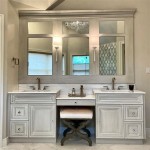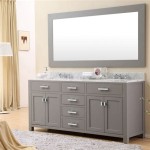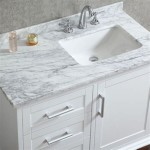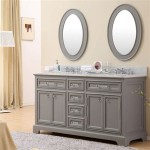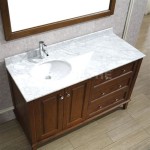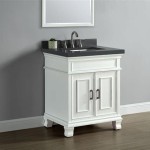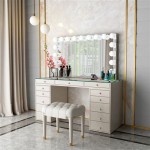Choosing the Right 24-Inch Bathroom Vanity
The 24-inch bathroom vanity is a common and practical choice for smaller bathrooms, powder rooms, and even as secondary vanities in larger master bathrooms. Its compact size allows for efficient use of space while still providing essential storage and a functional sink area. Understanding the various options available and the key considerations when selecting a 24-inch vanity is crucial for achieving a successful bathroom renovation or upgrade.
This article will delve into the different types of 24-inch bathroom vanities, material considerations, style options, and installation factors to assist in making an informed decision. The goal is to provide a comprehensive overview that empowers individuals to choose a vanity that meets their specific needs and aesthetic preferences.
Understanding Size and Space Considerations
The defining characteristic of a 24-inch bathroom vanity is its width. This measurement refers to the horizontal dimension of the vanity cabinet. While the width is standardized, the depth and height can vary slightly depending on the manufacturer and style. It is imperative to accurately measure the available space in the bathroom before making a purchase. Consider not only the vanity's footprint but also the clearances needed for comfortable use. The space in front of the vanity should allow for free movement and easy access to the sink. Ensure that doors and drawers can fully open without obstruction and that the vanity does not impede access to the toilet or shower.
In small bathrooms, every inch counts. A 24-inch vanity can be a strategic choice to maximize functionality without overwhelming the space. Alternative configurations, such as wall-mounted vanities, can further optimize the use of floor space. Wall-mounted vanities create an illusion of spaciousness and simplify cleaning beneath the unit. Understanding the spatial constraints and opportunities within the bathroom is a critical first step in selecting the appropriate vanity size and style.
Beyond the physical dimensions, consider the visual impact of the vanity on the overall bathroom design. A vanity that is too large can make a small bathroom feel cramped, while a vanity that is too small may appear inadequate. Striking a balance between functionality and aesthetics is key to creating a harmonious and well-proportioned bathroom.
Exploring Different Vanity Styles and Configurations
24-inch bathroom vanities are available in a wide array of styles to complement diverse design preferences. Traditional vanities often feature ornate detailing, raised panel doors, and classic hardware. These vanities evoke a sense of elegance and sophistication, often incorporating materials like solid wood and granite countertops. Contemporary vanities, on the other hand, typically showcase clean lines, minimalist designs, and sleek hardware. They may utilize materials like engineered wood, glass, and stainless steel to create a modern and streamlined aesthetic.
Transitional vanities represent a blend of traditional and contemporary elements, offering a versatile option that can seamlessly integrate into various bathroom styles. These vanities often incorporate classic design elements with modern materials and finishes. Farmhouse-style vanities are another popular choice, characterized by rustic wood finishes, apron-front sinks, and vintage-inspired hardware. These vanities create a warm and inviting atmosphere, often featuring reclaimed or distressed wood elements.
In addition to style, the configuration of the vanity can also vary. Some 24-inch vanities feature a single door cabinet with interior shelving, while others offer a combination of drawers and cabinets. The choice of configuration will depend on the specific storage needs and preferences. Drawers are ideal for organizing smaller items like toiletries and makeup, while cabinets are better suited for storing larger items like towels and cleaning supplies. Some vanities may also include a false drawer front to conceal the plumbing, providing a clean and seamless look.
Wall-mounted vanities represent a distinct configuration that offers several advantages. By suspending the vanity above the floor, they create an open and airy feel, making the bathroom appear larger. Wall-mounted vanities also simplify cleaning underneath the unit, preventing the accumulation of dust and debris. However, installing a wall-mounted vanity requires careful consideration of the wall structure and plumbing connections to ensure proper support and stability.
Material Considerations for Durability and Aesthetics
The materials used in the construction of a 24-inch bathroom vanity significantly impact its durability, aesthetics, and overall value. Solid wood vanities are known for their strength, beauty, and longevity. Hardwoods like oak, maple, and cherry are popular choices, offering resistance to moisture and wear. However, solid wood vanities can be more expensive and may require special care to prevent warping or cracking in humid environments.
Engineered wood, such as plywood and MDF (medium-density fiberboard), is a cost-effective alternative to solid wood. Engineered wood is more resistant to moisture and warping than solid wood, making it a suitable option for bathrooms. However, the quality of engineered wood can vary, so it is important to choose a vanity made with high-quality materials and construction techniques.
The countertop material also plays a crucial role in the vanity's overall appearance and functionality. Granite countertops are highly durable, heat-resistant, and stain-resistant, making them a popular choice for bathrooms. Quartz countertops offer similar benefits to granite but are non-porous, making them even more resistant to stains and bacteria. Marble countertops are known for their luxurious appearance but are more porous and susceptible to staining and etching. Laminate countertops are a cost-effective option that offers a wide range of colors and patterns. However, laminate is less durable than natural stone and can be susceptible to scratches and water damage.
The sink material is another important consideration. Ceramic sinks are durable, easy to clean, and resistant to stains and scratches. Porcelain sinks offer a similar aesthetic to ceramic but are more resistant to heat and chemicals. Stainless steel sinks are a modern and durable option, but they can be prone to water spots and scratches. Glass sinks offer a unique and contemporary look, but they require careful maintenance to prevent scratches and watermarks.
Hardware, such as knobs and pulls, can significantly impact the vanity's overall style. Choose hardware that complements the vanity's design and finish. Consider materials like brushed nickel, chrome, oil-rubbed bronze, and matte black to coordinate with other bathroom fixtures and accessories. The quality of the hardware is also important, as it will be subject to frequent use. Opt for solid and well-made hardware that will withstand daily wear and tear.
The finish of the vanity can also affect its durability and appearance. Painted finishes offer a wide range of color options and can be easily updated. Stained finishes showcase the natural grain of the wood and provide a warm and inviting look. Consider the humidity levels in the bathroom when choosing a finish. Moisture-resistant finishes are essential to prevent water damage and extend the vanity's lifespan.
Ultimately, the choice of materials will depend on individual preferences, budget constraints, and the overall aesthetic of the bathroom. Consider the long-term durability and maintenance requirements of each material before making a decision. Investing in high-quality materials will ensure that the vanity remains beautiful and functional for years to come.
Consider the environmental impact of the materials chosen. Opting for sustainable materials, such as reclaimed wood or low-VOC finishes, can contribute to a healthier and more environmentally friendly bathroom.
Installation Considerations and Plumbing Compatibility
Proper installation is crucial to ensure the stability and functionality of a 24-inch bathroom vanity. Whether installing the vanity yourself or hiring a professional, it is important to carefully follow the manufacturer's instructions. Begin by preparing the installation area, ensuring that the floor is level and the plumbing connections are accessible. Turn off the water supply to the existing sink and disconnect the drain and supply lines.
For floor-mounted vanities, carefully position the vanity in place, ensuring that it is level and stable. Use shims if necessary to correct any unevenness in the floor. Secure the vanity to the wall studs using screws or anchors to prevent it from tipping or shifting. For wall-mounted vanities, carefully locate the wall studs and attach the mounting brackets to the studs using lag bolts or screws. Ensure that the brackets are level and securely fastened to the wall. The wall must be structurally sound to support the weight of the vanity and its contents.
Plumbing compatibility is a critical consideration during installation. Ensure that the vanity is compatible with the existing plumbing connections, including the drainpipe and water supply lines. You may need to adjust the plumbing to accommodate the new vanity's sink and faucet. Flexible supply lines can be used to connect the water supply to the faucet, allowing for some flexibility in the plumbing connections. Be sure to use Teflon tape on all threaded connections to prevent leaks.
Connect the drainpipe to the sink drain using a P-trap, which prevents sewer gases from entering the bathroom. Ensure that the P-trap is properly aligned and tightened to prevent leaks. Check for any leaks in the plumbing connections by turning on the water supply and running the faucet. Tighten any loose connections as needed.
If you are not comfortable with plumbing or carpentry work, it is best to hire a professional installer to ensure that the vanity is installed correctly and safely. A professional installer will have the necessary tools and expertise to handle any unforeseen challenges that may arise during the installation process. Proper installation will not only ensure the vanity's functionality but also prevent costly repairs in the future.
After installation, inspect the vanity for any damage or defects. Clean the vanity thoroughly and apply a protective sealant to the countertop to prevent stains and water damage. Proper maintenance will help to extend the life of the vanity and keep it looking its best.

Sedgewood 24 1 2 In W Bath Vanity White With Solid Surface Technology

Donovan Single Bathroom Vanity 48 Teak West Elm

Home Decorators Collection Hanna 24 In Single Sink White Bath Vanity With Engineered Stone Top Assembled 24w

Harrison Single 24 Bath Vanity Celadon Lacquer Matte Black Hardware West Elm

Bathroom Vanity 24 Inch Small Bath With Sink Modern Cabinet Free Standing Combo 3 Drawers Brown

Home Decorators Collection Hanna 24 In Single Sink Weathered Tan Bath Vanity With White Engineered Stone Top Assembled 24wt

Bilston 24 In Single Sink White Bath Vanity With Engineered Stone Top Assembled

Klein 24 Wide 2 Drawer Porcelain White Single Sink Vanity 74t48 Lamps Plus

24 Inch Bathroom Vanity With Sink Floor Mounted One Piece Cabinet Walnut Black Basin

Project Source White Single Sink Bathroom Vanity With Cultured Marble Top
